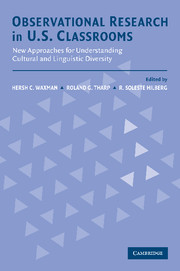 Observational Research in U.S. Classrooms
Observational Research in U.S. Classrooms Published online by Cambridge University Press: 23 November 2009
Mai knew that the teacher wanted her to become a good writer. And the teacher, Mrs. Galinski, had the students write every day in this 2-hour summer school class. For a half hour each morning, they would read a newspaper article individually and then discuss it as a class. Next, they had 30 minutes to write about the topic in their journals. Sometimes Mai understood the topic, like the article about teenagers getting drunk and crashing a car, but at other times she didn't, like the article on global warming, which had a lot of unfamiliar science words. For 20 minutes (after a 10-minute break), students would then volunteer to read their story or essay aloud, but Mai was too nervous about her English skills and her writing ability to speak up. The American students read aloud, and once in a while one of her fellow English as a Second Language (ESL) classmates took the chance too. Mrs. Galinski would comment on the students' texts, but Mai and the other students didn't. The class ended with 30 minutes of sustained silent reading, which Mai enjoyed because she could read what she wanted to and never had to talk about it. At the end of the class, the teacher would collect their journals and mark them in the evening, returning them the next day. Mai would try to understand the teacher's comments, but she wasn't sure her writing was improving. The teacher would write “Awkward phrasing,” “Verb tenses don't match,” “No clear antecedent,” and “Use more descriptive words,” but Mai didn't know what to do.[…]
To save this book to your Kindle, first ensure [email protected] is added to your Approved Personal Document E-mail List under your Personal Document Settings on the Manage Your Content and Devices page of your Amazon account. Then enter the ‘name’ part of your Kindle email address below. Find out more about saving to your Kindle.
Note you can select to save to either the @free.kindle.com or @kindle.com variations. ‘@free.kindle.com’ emails are free but can only be saved to your device when it is connected to wi-fi. ‘@kindle.com’ emails can be delivered even when you are not connected to wi-fi, but note that service fees apply.
Find out more about the Kindle Personal Document Service.
To save content items to your account, please confirm that you agree to abide by our usage policies. If this is the first time you use this feature, you will be asked to authorise Cambridge Core to connect with your account. Find out more about saving content to Dropbox.
To save content items to your account, please confirm that you agree to abide by our usage policies. If this is the first time you use this feature, you will be asked to authorise Cambridge Core to connect with your account. Find out more about saving content to Google Drive.